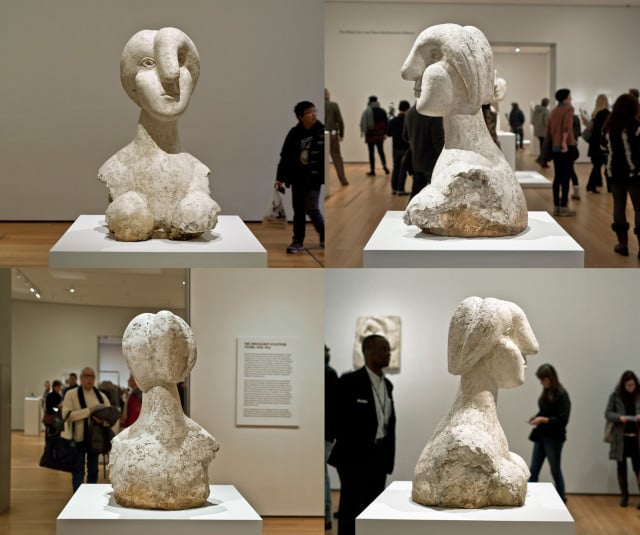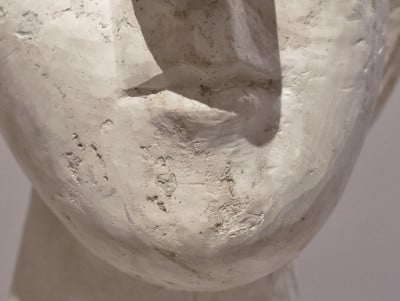Analysis
Is Picasso’s $100 Million ‘Bust’ at the Heart of Gagosian Lawsuit Gem or Junk?
THE DAILY PIC: Is the sculpture at MoMA worth the battle raging over it?

THE DAILY PIC: Is the sculpture at MoMA worth the battle raging over it?

Blake Gopnik


(Photos by Lucy Hogg)
THE DAILY PIC (#1475): That mouth alone is worth $100 million. It’s as lovely, sensitive a pair of lips as anyone could ask for, and the battle for ownership of Picasso’s Buste de Femme (Marie-Thérèse ), from 1931, makes a bit more sense once you take it in.
That sculpture has been much in the news of late: An ongoing lawsuit has revealed that some Qatari royals thought they had struck a deal to buy it from Picasso’s daughter for about $42-million, only to have her cancel the transaction and then later sell it to megadealer Larry Gagosian for more than $100 million.
Of course, as always when these kind of stories break, vast attention gets paid to the price tag and almost none to the work of art it’s attached to. With that in mind, I headed back to “Picasso Sculpture”, the great show now at the Museum of Modern Art in New York, to take another look at the zillion-dollar bust. I’d seen it on several visits to the show over the last few months but had never really focused on it – there were much better works to spend time with, such as Picasso’s world-changing Guitar and his tiny women carved from stretcher bars, on view right by his Buste. My fellow visitors had also mostly ignored the Marie-Thérèse before news of its purchase(s) broke; on my latest visit, however, a guard was permanently posted by its side and Instagramers were all over it.
I can’t honestly say that Marie–Thérèse’s mouth is what first grabbed my attention. The most obvious feature of the bust is the way Picasso has draped his penis over the poor woman’s forehead to make it stand for her nose – a nose enlarged, thanks to Picasso, into a proboscis even Barbara Streisand might find de trop. Whatever identity Marie–Thérèse had before she met Pablo gets subsumed, at least in his mind and this sculpture, into her role as an extension and vehicle for his overweening masculinity.
Look at the bust from the back, and you realize that the entire sculpture is phallic. It might as well be titled Pablo Picasso: Self-Portrait as his Woody. From the front, the artistic convention that cuts a bust off below the shoulders becomes, in Picasso’s hands, something closer to a double mastectomy in progress on his mistress. Add in her gouged-out eyes and Picasso’s reputation for misogyny gets fully confirmed.
I’m not sure any of the sculpture’s current pursuers, in Qatar and the U.S., really bothered subjecting it to sober art-critical analysis. All they really needed to think about was what the market might value it at, now and in the future. After all, people pay vast sums for collectibles with no aesthetic value at all: A few grams of sparkly stone (compressed coal that won’t even burn) and old stamps that can barely mail a letter (today, you’d need 63 Penny Blacks just to send an envelope across London). Gagosian and the Qataris probably noticed that the bust is unusually big – great art is basically priced by the inch – but I’m not sure they thought all that much deeper than that.

And now back to that mouth – beautiful, delicate, sweet … priceless? It’s as though Picasso needed to acknowledge the beauty of his mistress, and maybe also his real love for her, even as he brutalized her in art. Or it could be that he realized her lovely mouth was crucial to giving the rest of the piece its brutality. That’s partly through simple contrast: The beauty of the mouth makes the work’s grotesqueries that much more grotesque. But there’s also a sense that the mouth’s realism makes it impossible to write off the distortions elsewhere as accidental byproducts of the sculpture’s stylizations. That is, if the mouth is “real” then Marie-Thérèse’s nose must be, too, and must really look like a huge phallus. (That’s why Salvador Dali’s realism makes his brand of Surrealism creepier that more stylized versions.)
I wonder if that mouth also played at least a small a part in the current battle-of-the-bust. If you only took a quick look at the sculpture – the kind of glance you’d give a jpeg sent over to Qatar by your art consultant – the mouth might make you think you’d got hold of one of Picasso’s easier, more palatable, more naturalistic pieces. It’s well known that Picasso’s truly epochal, wildly difficult Cubist works do less well on the market than his early Blue pictures and later Surreal ones. If the market had brains where its billfold is, however, it would realize that, rather than being a charming masterpiece, this $100 million bust is a work of tragic genius – and one that no one should want to live with. Its mouth is a rare trace of beauty in an object that’s otherwise violent.
I hate Picasso’s male-chauvinist vision of women, but I have to admire how brilliantly he builds it.
Correction: This article initially stated that the original sales agreement was cancelled because of a higher offer from Mr. Gagosian. His gallery said that that cancellation occurred before Gagosian was involved in the purchase of the bust.
For a full survey of past Daily Pics visit blakegopnik.com/archive.